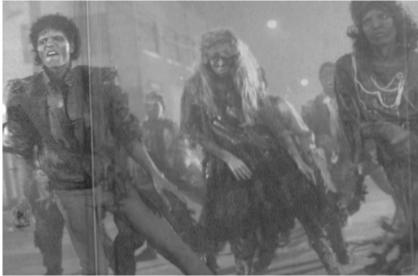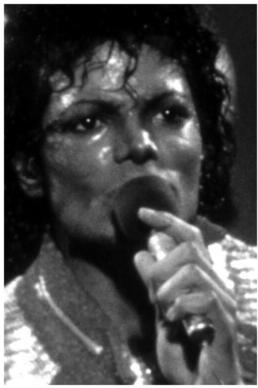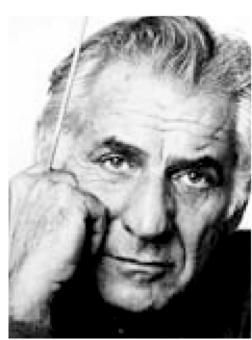Jacko, His Rise and Fall: The Social and Sexual History of Michael Jackson (35 page)
Read Jacko, His Rise and Fall: The Social and Sexual History of Michael Jackson Online
Authors: Darwin Porter

When Michael finally broke away, he was astonished to hear Bernstein
say: "I hear that AIDS can be acquired by an exchange of saliva. Let's hope
that both of us are not entertaining something really wicked in our blood
streams."
Bernstein invited Quincy to a private viewing of the Sistine Chapel which
he'd arranged through his Vatican connections. Both men lay on the floor
looking up at the Michelangelo masterpiece. Studying the artist's figures carefully, Bernstein exclaimed: "Look at that! Michelangelo doesn't know what a
woman looks like. He was as gay as I am. Those are just guys with tits!"
At the end of the world tour, plans went forward to make a video of
"Thriller." But the 14-minute video would be delayed by a year and a half
after the release of the album.
Sales had slumped, but after the release of the video, the album once again
repeated its steady climb up the charts. Fans around the world treated the
arrival of the video like the premiere of a major film. Quincy Jones claimed
that Michael's video "made a sensation in tandem with the rise of video as an
art form."
In a very short time, Michael would become even more celebrated
because of his videos. One eyewitness on the set where "Thriller" was filmed
recalled the moment. "Jackson's body tenses. Energy shoots through his body
like a bolt of lightning. As he faces the camera, he seems to spit out the lyrics.
His usually fragile voice suddenly takes on a dynamic tone. He can be heard
over the deafening playback. He grips his left sleeve with his right hand and
jerks it upward. He growls the chorus to the camera. He doesn't dance but
seems to glide. He launches into one of his famous spins-a trio of turns in succession."
In the video, Michael is transformed into both a zombie and a werewolf,
thereby challenging its director, John Landis, who had previously directed An
American Werewolf in London. Landis cast Ola Ray as Michael's girlfriend.
Because of Michael's strong religious beliefs, she concealed from him that she
had been a Playboy centerfold in 1980.
Before she was tapped to appear with Michael in the "Thriller" video,
Ray, who came from St. Louis, had appeared as a hooker in the 1981 film,
Body and Soul. She'd also appeared as hookers in the 1982 Night Shift and in
48 Hrs., released the same year. "Thriller" was obviously the highlight of her
career, but she continued to do minor film and TV work, appearing as a
Playboy playmate in Beverly Hills Cop II, released in 1987.
In the "Thriller" video, choreographed zombies perform with Michael. He
and the "undead" stage a fantastic song-and-dance number, which the Pulitzer
Prize-winning critic for The New York Times, Margo Jefferson, called
"Walpurgisnacht in suburbia."
The choreography in the "Thriller" video would have taxed the talents of
Jerome Robbins. The dance sequences were filmed within the underground
concourse at the Rockefeller Center subway stop in Manhattan. The video cost
a million dollars.
After the airing of "Thriller" on MTV, and its subsequent worldwide success, all major stars-both black and white-demanded a music video to promote their recordings. A tie-in video with the release of an album became
mandatory. Michael single-handedly had revolutionized the music business.
Two shorter but still successful videos were released from the Thriller
album, "Billie Jean" and "Beat It."
By the time of his release of the video "Billie Jean," Michael had a new
"wet look" to his hair. He'd plucked his eyebrows, now heavy with eyeliner.
His dancing was slicker, his clothing more "with it." On one occasion he wore
black leather trousers and a
black leather jacket like
Elvis Presley himself.

"Thriller"
The video, "Beat It,"
was a sort of mini-version
of West Side Story, with the
urban violence updated to
the 1980s. It was the most
viewed video during the
summer of 1983.
With its theme of gang
warfare, "Beat It" was as stunning as "Billie Jean." Actual gang members
from the streets of Los Angeles appeared in the
video along with professional dancers.

MJ in "Thriller"
The "Thriller" video had been paid for by
Branca's skillful negotiations of distribution
deals. Meeting with Michael, the two men conceived an even more daring plan: they'd make a
documentary on the making of the hit video, and
would call it "The Making of `Thriller."'
Yetnikoff was instrumental in getting MTV
to participate financially. Before that, he'd
denounced MTV as "racist assholes" for presenting only white performers. But MTV, recognizing the unprecedented appeal of Michael,
finally came around, even putting up some of
the money for the financing of the second
"Thriller" video. These videos opened the doors of MTV to other emerging
black performers.
Jerry Kramer was called in to direct "The Making of `Thriller."' "As a
professional, Michael is like a Zen monk," Kramer later said. "He's focused
on a singular goal, his work, his art, which he constantly tries to take to a
celestial level."
Long after the release of the "Thriller" video, a story leaked out to the
press that under threat of expulsion from the Jehovah's Witness cult, Michael
once ordered Branca to destroy the "Thriller" video, even though it had been
financed by Vestron, Showtime, and MTV. Branca, at least in front of Michael,
agreed to do that, but he had no intention of actually destroying the video.
Finally, a last-minute compromise was reached thanks to the insertion of a disclaimer: "Due to my strong personal convictions, I wish to stress that this film
in no way endorses a belief in the occult-Michael Jackson."
Later on, to pacify the more fanatical of the Jehovah's Witnesses,
Michael, in an issue of Awake! on May 22, 1984, tried to distance himself
from "Thriller." He promised, "I'll never do a video like that again! In fact, I
have blocked further distribution of the film over which I have control, including its release in some other countries. There's all kinds of promotional stuff
being proposed for `Thriller.' But I tell them, `No, no, no. I don't want to do
anything on `Thriller.' No more 'Thriller."'
Not all the Jehovah's Witnesses disapproved of Michael, although church
leaders did. A radical cult within the sect itself came up with the startling
belief that Michael was "an incarnation of the Archangel Michael, a symbol
of the arisen Christ."

Leonard Bernstein
Wearing a pink shirt and a red bow tie, with
black leather pants and a jacket, Michael
appeared live at the 1983 hoedown celebrating
Motown's 25th anniversary. Michael at first
refused to appear, but was eventually cajoled
into performing. He electrified audiences.
On stage Michael had a reunion with his
errant brother, Jermaine, who had voiced criticism of Michael for "trying to be white" to the
press. Berry Gordy pleaded with Michael to do
a solo number from Motown's long list of hits,
but Michael adamantly refused, preferring to
lip-sync his rendition of "Billie Jean."
It was take that choice or leave it," Gordy
later said. "I caved in just to get Michael out there on stage."
Some fifty million people tuned in to watch Motown 25: Yesterday, Today,
and Tomorrow. Michael startled audiences with his "Moonwalk." Actually
he'd ripped off the dance, in which he seemed to be gliding in opposite directions simultaneously, from inner-city black break dancers in the 1970s.
From that night on, Michael also became known as "The Gloved One."
Many fans thought he'd introduced the lone white-sequined glove that night.
But he'd been wearing such a glove since the late 1970s. Sammy Davis Jr.
thought Michael was paying homage to old-fashioned black minstrel shows,
or making a tribute to Al Jolson. Motown 25 turned out to be the highest-rated
variety show in the history of TV.
In less than a decade after Michael's Motown 25 appearance,
Entertainment Weekly hailed the performance as one of the greatest entertainment moments of the 20th century. The article wrote of "a delicate young man
with a choked voice, a white glove, and magic shoes. He took the microphone
and began to write the next chapter of American music history. The moment
Michael Jackson ripped into his single, `Billie Jean'-squealing, moaning,
spinning, and finally taking the viewer's breath away, with his Moonwalkthe music industry had to throw away its old yardsticks of success."
Two of the greatest dancing stars of all time, Fred Astaire and Gene Kelly,
watched Michael's "Moonwalk." The next day, each of them called Michael,
asking to meet him. Although shy about meeting two of his all-time favorites,
Michael eagerly set up times to see each of these talented stars of the Golden
Age, from whom he had stolen so many of his own dance steps, adapting
them, of course.
Both Gene Kelly and Fred Astaire were idols to Michael, and he also
understood the different artistry of each dancer. Critic Steve Vineberg once noted that the two performers were a study in contrasts with different personal styles. He called Astaire "a natural aristocrat, movie musicals' closest
equivalent to Cary Grant."
"If Fred Astaire is the Cary Grant of dance, I'm the Marlon Brando,"
Kelly said.
"Astaire was astonishingly lithe, perhaps the most graceful man who ever
walked-let alone danced-across a movie set," Vineberg claimed.
On the other hand, Vineberg found that Kelly evoked Jimmy Cagney.
"Kelly's style was rooted in vaudeville and the brash, crowing apple-pie musicals of George M. Cohan," Vineberg said. "He was an athlete, a two-fisted
Irishman."
The first telephone call of the morning to Michael at his Encino home was
from Astaire. The dancer told Michael that he'd taped the show and had gotten up early that morning to watch the program again.
"You're a hell of a mover," Astaire told Michael. "Man, you really put
them on their asses last night."
After Michael thanked him, Astaire said, "You're an angry dancer. I'm the
same way. I used to do the same thing with my cane."
In the days to come, Astaire invited Michael over to his Beverly Hills
home. There, Michael taught Ginger Rogers' former dance partner how to
Moonwalk. Astaire was eighty-four years old at the time. So impressed was
he with Michael's steps that Astaire asked Hermes Pan to come over one
night, as he wanted Michael to teach the dancer/choreographer also how to
Moonwalk.
Michael admired Astaire, but he also had great respect for the talent of
Hermes Pan, the Nashville-born artist responsible for choreographing every
one of the nine Astaire-Rogers 1930s gems as well as Fred and Ginger's 1949
screen swan song, The Barkleys of Broadway. Pan also choreographed Betty
Grable musicals in the 40s and danced on screen with both the "Blonde
Bombshell," as she was called, and Hollywood's princess, Rita Hayworth.
Michael asked Astaire how he climbed the walls and danced on the ceiling in the 1951 Royal Wedding.
Astaire finally admitted how this trick shot was done. "The whole room
revolved, and I was on the ground the whole time. The camera, the cameraman, and the room all turn, and I'm the one who does the climbing. It required
a special set. We called it the Iron Lung, and it was constructed by Bethlehem
Steel. Not only did the camera and cameraman revolve 360 degrees, the light
for the set revolved as well. It's too difficult to explain. But don't you dare
copy it from me. That scene belongs just to me."
